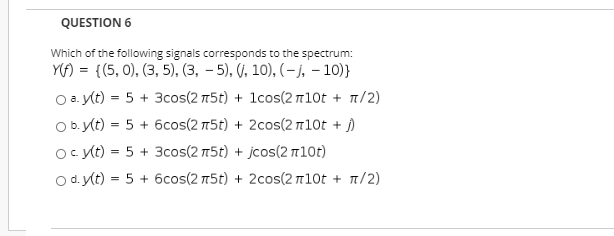Which of the following signals corresponds to the spectrum: YA) = {(5, 0), (3, 5), (3, – 5), (), 10), (– j, – 10)} O a y(t) = 5 + 3cos(2 5t) + 1cos(2 n10t + n/2) Ob.Kt) = 5 + 6cos(2 75t) + 2cos(2 110t + j) oc yt) = 5 + 3cos(2 75t) + jcos(2 n10t) O d. y(t) = 5 + 6cos(2 15t) + 2cos(2 110t + n/2)
Which of the following signals corresponds to the spectrum: YA) = {(5, 0), (3, 5), (3, – 5), (), 10), (– j, – 10)} O a y(t) = 5 + 3cos(2 5t) + 1cos(2 n10t + n/2) Ob.Kt) = 5 + 6cos(2 75t) + 2cos(2 110t + j) oc yt) = 5 + 3cos(2 75t) + jcos(2 n10t) O d. y(t) = 5 + 6cos(2 15t) + 2cos(2 110t + n/2)
Related questions
Question
100%

Transcribed Image Text:Which of the following signals corresponds to the spectrum:
YA) = {(5, 0), (3, 5), (3, – 5), (), 10), (– j, – 10)}
O a y(t) = 5 + 3cos(2 5t) + 1cos(2 n10t + n/2)
Ob.Kt) = 5 + 6cos(2 75t) + 2cos(2 110t + j)
oc yt) = 5 + 3cos(2 75t) + jcos(2 n10t)
O d. y(t) = 5 + 6cos(2 15t) + 2cos(2 110t + n/2)
Expert Solution
This question has been solved!
Explore an expertly crafted, step-by-step solution for a thorough understanding of key concepts.
This is a popular solution!
Trending now
This is a popular solution!
Step by step
Solved in 4 steps with 4 images
